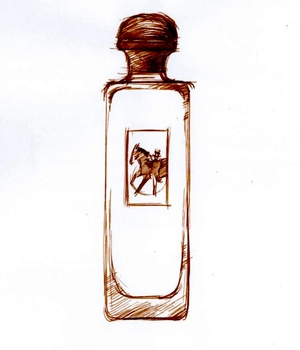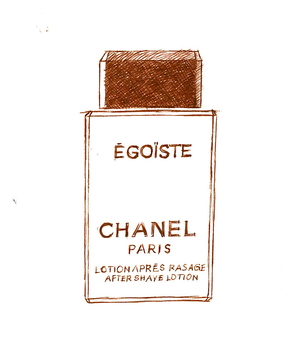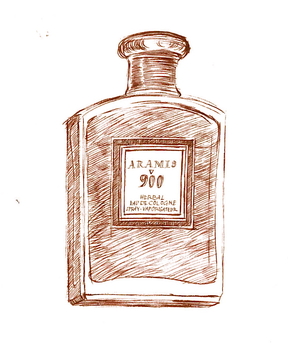Tagged With ‘carnation’
Hermès
Equipage Géranium
29 November, 2015
 Equipage is such a classic perfume that it’s tempting to ask why anyone would mess with it, but that’s a bit like wondering why anyone would want to reinterpret the Beatles’ original version of Yesterday.
Equipage is such a classic perfume that it’s tempting to ask why anyone would mess with it, but that’s a bit like wondering why anyone would want to reinterpret the Beatles’ original version of Yesterday.
Created by the perfumer Guy Robert and launched in 1970, Equipage was the first Hermès perfume to be designed specifically for men, and Robert composed a rich, subtly spicy scent which includes – among many other things – bergamot orange, jasmine, lily of the valley and clove-scented carnations.
Forty-five years on, the company’s in-house perfumer, Jean-Claude Ellena, has revisited three of its classics, in each case pairing them with a new ingredient. First came Bel Ami Vétiver, followed by Rose Amazone, and now we have his updated version of Equipage – Equipage Géranium.
If Ellena’s attempt to give Equipage a modern twist isn’t (to my nose at least) entirely successful, his choice of geranium (or pelargonium, to be botanically correct) as a new ingredient is a typically clever and imaginative one. Though the leaves of different species of pelargonium smell of everything from lemon to cinnamon, most of the so-called geranium oil used in perfumery comes from a single South African species, Pelargonium graveolens. As with all natural ingredients, geranium oil comes in a range of different grades, but they generally share a fresh, slightly sharp smell that’s usually described as both fruity and minty, often with a hint of rose.
I’m guessing that it was the fresh, minty element of geranium oil that appealed to Jean-Claude Ellena, and Equipage Géranium does smell a tiny bit fresher and sharper than the original Equipage – but it’s a subtle twist rather than a radical reinvention. I’m not sure it’s sufficiently different to make it worth choosing over the original, but unlike many of Ellena’s perfumes, which are always refined but sometimes stripped down until they’re slightly colourless, Equipage Géranium retains all the richness and complexity of its inspiration. Given the crude simplicity of so many modern scents, that’s a quality to be celebrated.
Chanel
Egoïste
22 July, 2014

The first thing I think when I smell Egoïste is ‘spicy!’ It’s a big, bold, in-your-face fragrance, well-suited to its name, which doesn’t suit everyone – in fact I’ve never thought it really suited me. But if you have the confidence to carry it off it’s a superb perfume of its kind.
Egoïste was created by Chanel’s long-standing in-house perfumer, Jacques Polge, and released in 1990 with the kind of blitzkrieg advertising that Chanel does so well. Possibly too well, since I suspect that fewer people remember the perfume than Jean-Paul Goude’s brilliant film, in which a bevy of deranged-looking models screamed ‘Egoïste!’ while slamming open and shut the blinds of a scaled-down version of the Hôtel Carlton in Cannes.
But back to the perfume. The spiciness of Egoïste is of the sneeze-inducing peppery kind, and for a long time I assumed it was just that – black pepper, mixed with the scents of (among other things) rose, vanilla and sandalwood. But looking at the ingredients again I wonder if at least some of the pepperiness actually comes from carnation – not the scentless supermarket kind but those wonderful old-fashioned ‘clove-scented’ carnations, which have an intoxicating, slightly peppery smell all their own.
The reason I rarely wear Egoïste, though, is less to do with its pepperiness than with another of its main ingredients: vanilla. I’ve no doubt that Chanel uses only the finest quality vanilla in its perfumes, but it’s simply not a smell that – in fragrances, at least – I particularly like. Part of the problem is that, for a while, vanilla was so widely used in perfumes aimed at young women, with the result that (to me at least) it smells too sweet and teenage-girly. And it’s such a foody smell as well: I love what vanilla does to chocolate, but I’m not sure I want to wear it on my skin.
Still, like any work of great skill, I admire its artistry, even if it doesn’t seem to suit me. If you haven’t already tried it then give it a go and see if it works for you.
Hermès
Equipage
14 July, 2014
 Equipage is a perfume I hadn’t smelled for years. I had a bottle long ago, but when it ran out I never got round to replacing it. Actually I’d forgotten how good it smells, so I’m delighted to have it back. It’s as timeless and well made as a piece of Hermès saddlery, and it even has something of the same comforting, leathery smell.
Equipage is a perfume I hadn’t smelled for years. I had a bottle long ago, but when it ran out I never got round to replacing it. Actually I’d forgotten how good it smells, so I’m delighted to have it back. It’s as timeless and well made as a piece of Hermès saddlery, and it even has something of the same comforting, leathery smell.
The first Hermès perfume to be aimed at men, Equipage was created by Guy Robert, one of the leading perfumers of his generation. You could say that Robert had perfume in his blood. He learned his trade in Grasse, once the world capital of perfumery and still an important production centre today. His uncle, Henri Robert, succeeded Ernest Beaux as perfumer-in-chief at Chanel, where he created No.19 and Pour Monsieur.
Equipage shares much of its character with Pour Monsieur, smelling effortlessly grown-up, discreet and rather conservative. The funniest comment I’ve seen online is that it ‘makes you smell ten years older. Richer, maybe; but older’, and I think that’s right, but now I’m older myself it’s nice to at least smell rich.
For a men’s perfume it has rather more floral ingredients than one might expect, including lily of the valley, jasmine and carnation, but they’re so subtly blended together that you’d never know. The flowers give it a little sweetness, but that’s balanced by the spicy, clove-scented edge of carnation. Equipage also contains a lot of orange, in the form of bergamot, squeezed from the peel of the Sicilian bergamot orange, Citrus bergamia, which is also used to flavour Earl Grey tea.
But that’s not all. This rich and complex fragrance also includes oakmoss (or a synthetic equivalent), which is actually a type of lichen that smells like a forest after rain; as it happens oakmoss also features in Pour Monsieur and Chanel No19. You might also be able to smell a touch of patchouli, that favourite 1970s fragrance, and perhaps a little Badedas-like pine – another forest touch.
There’s much, much more, which makes Equipage worth returning to again and again. It may not be the most avant-garde of fragrances, but if you want something reassuringly luxurious, it’s up there with the best.
Aramis
Aramis 900
9 June, 2014

Aramis is one of those mid-market brands that seems to have been around for ever, and for that reason it’s often overlooked or, worse, looked down upon. Which is, I think, a shame, because there are some classic men’s perfumes in the range.
The all-men’s brand was launched in 1964 by Estée Lauder and her husband Joseph, with the eponymous Aramis (which I’ve reviewed here) as the first fragrance in the range. Though I’d always assumed the brand and the perfume were named after the character in The Three Musketeers, legend has it that it actually commemorates an obscure town in Armenia, which these days is transliterated as Yeremes. It sounds like a leg-pull, but then we’re also told that the Lauders were working with an Armenian designer at the time by the name of Arame Yeranyan, so you never know; I’ll let you know if I can get a definitive answer out of somebody.
Whatever the truth of the matter (and the perfume industry’s relationship with historical fact can sometimes be rather shaky), Aramis was a big success, and in 1973 it begat Aramis 900. Like the original Aramis it was created by Bernard Chant, a brilliant French perfumer who loved spicy, leathery fragrances, and it’s very much along those lines.
In fact, as it’s often been pointed out, if Aramis 900 hadn’t been marketed for men, it would have worked just as well as a woman’s scent – a good example of the obvious but too rarely grasped fact that in itself perfume has no gender. Just smell Clinique’s classic woman’s perfume, Aromatics Elixir, and you’ll see what I mean: it was also created by Bernard Chant and to many people smells identical to Aramis 900.
Aramis 900 is a deep, spicy, complicated scent, which makes most contemporary offerings smell weedy and washed-out by comparison. Today you’d only expect to find a men’s fragrance smelling this rich and complex in an expensive ‘exclusive’ range like Tom Ford or Armani Privée, but when it was launched it was aimed squarely at the middle market: these were not expensive perfumes.
Like the majority of other men’s perfumes, Aramis 900 includes lemon and bergamot, but among its more persistent and powerful ingredients are carnation, orris (iris) root, geranium, oakmoss, patchouli and vetiver, as well as rosewood oil, the natural form of which comes from an increasingly threatened rainforest tree, Dalbergia nigra.
Unlike most modern men’s perfumes, though, Aramis 900 has a predominantly floral scent, which to me smells like a mix of clove-scented carnation and old-fashioned rose. Though floral fragrances were popular with Victorian men, in 20th-century western culture they came to be thought of as ‘girly’, though for no particularly logical reason as far as I can see.
Luckily that didn’t stop perfumers from using floral ingredients in men’s perfumes, but in the case of Aramis 900 those flowery scents are brilliantly disguised by all sorts of other things, including a faintly ‘dirty’ smell that adds an oddly sexy extra to the mix. The forest-floor oakmoss and vetiver also stop it smelling sweet, while the carnation (despite being a flower) gives it the same kind of peppery spiciness that you can smell in Chanel’s Egoïste.
The amazing thing, to me, is that perfumes like Aramis 900 have been so cheap for so long, but in 2009 it seems to have dawned on Estée Lauder Inc what they had on their hands, and six perfumes in the Aramis range – including Aramis 900 – were relaunched and repackaged in matching bottles. Now priced at a less mass-market £60 and titled a ‘Gentleman’s Collection’, presumably the hope is that men who liked one fragrance might go on to collect the rest. Given the quality of most men’s fragrances today I’d say that wouldn’t be a bad idea.